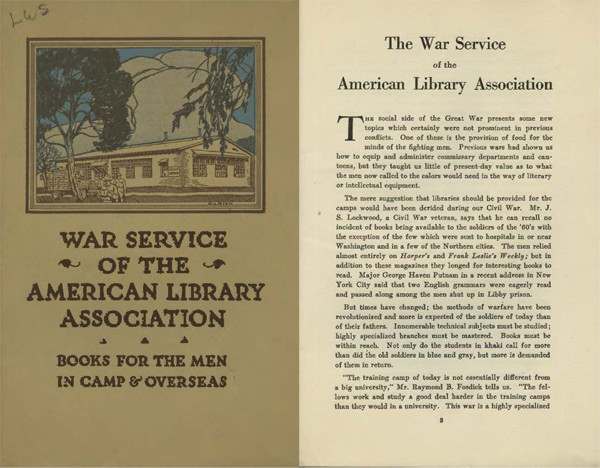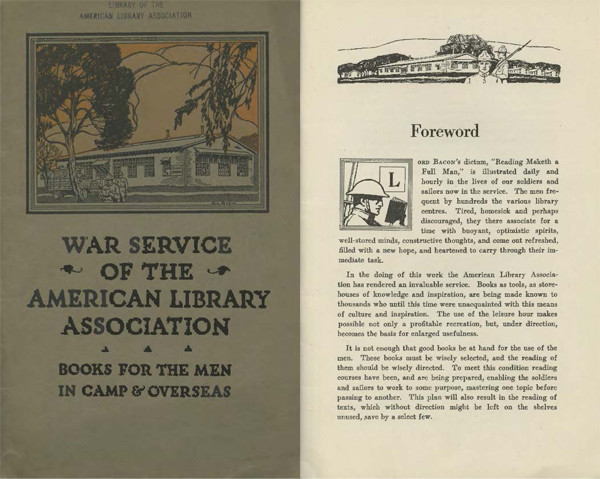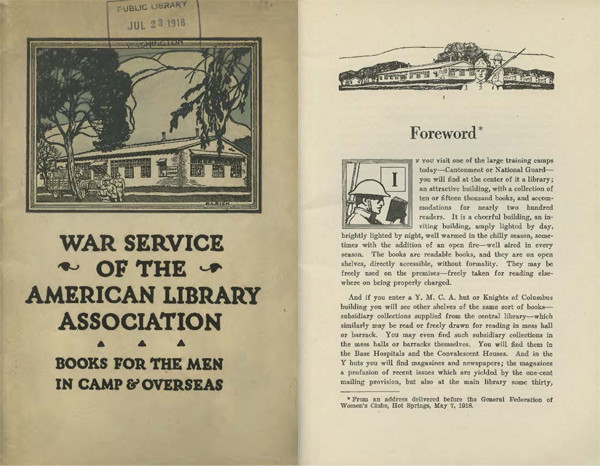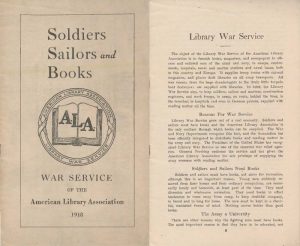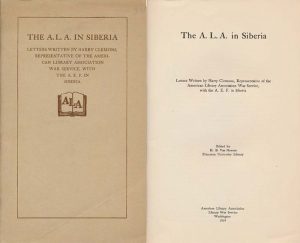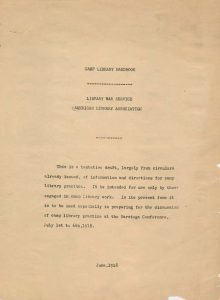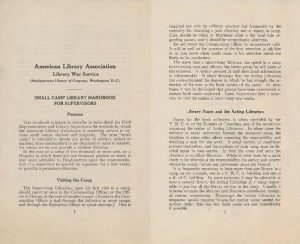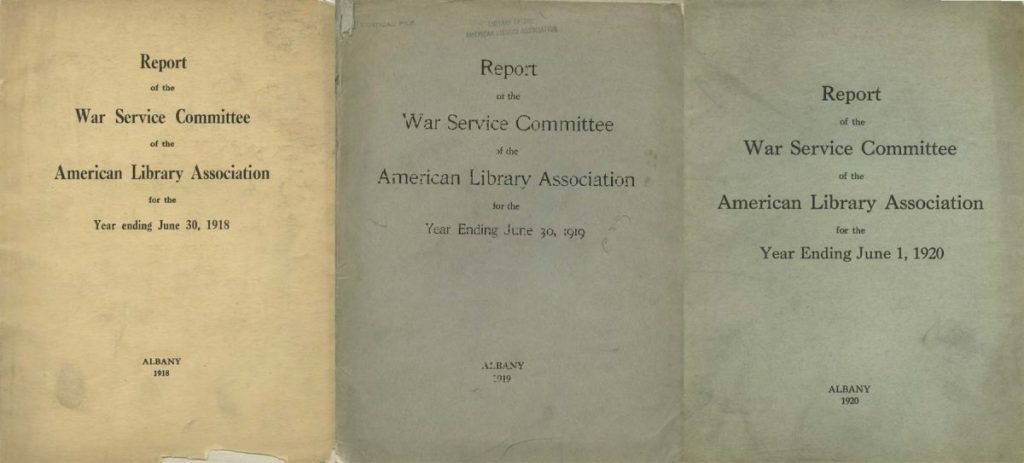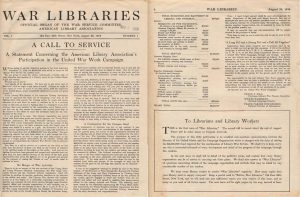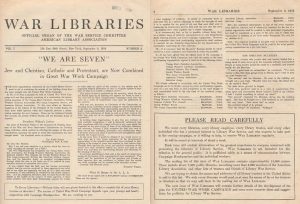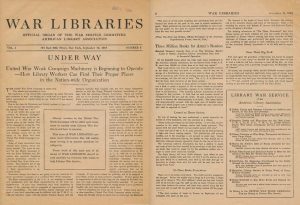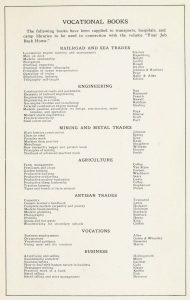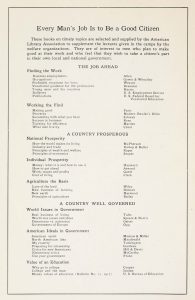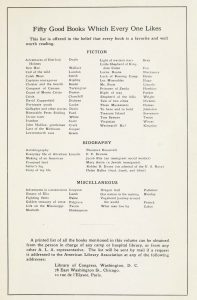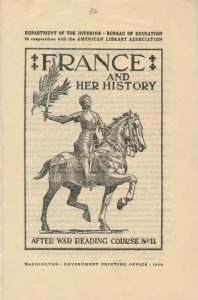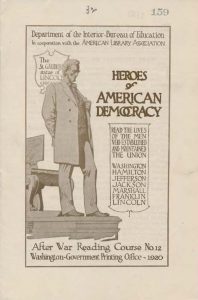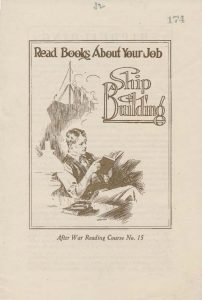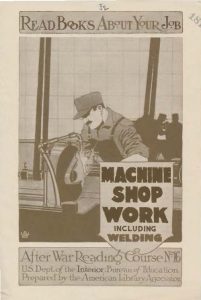While the ALA War Service supplied great amounts of reading materials to soldiers abroad, a great amount of administrative reading materials were produced too. These can be found in Record Series 89/1/60, which contains promotional pamphlets and administrative reports.
Read on to learn about Library War Service publications!
Books
A variety of books were produced for librarians and the greater public to describe what the A.L.A. War Service did and why it needed donations. Books for the Men in Camp & Overseas described the War Service and three successive editions were provided during 1918, leading up to a great book and financial drive in November at the time of the Armistice. Soldiers, Sailors, and Books is a lightweight publication that was cheaper to produce and to distribute. Finally, The A.L.A. in Siberia, like Books for the Men in Camp & Overseas, is a more expensive publication with a limited circulation.
Books for the Men in Camp & Overseas, (3 Editions), 1918
Books for the Men in Camp & Overseas by Theodore Wesley Koch, (Chief, Order Division, Library of Congress), was published in three editions in 1918: the first edition (February 1918); the second edition (April 1918); and the third edition (July 1918). Each edition increased the content of the previous edition.
First Edition, February 1918
The first edition includes a summary of the A.L.A. Library War Service’s purpose and services to American soldiers serving during World War One.
The publication includes descriptions of administrative costs, affiliated organizations, guidelines for donated materials, librarian volunteers, library building design, library services, library user needs, popular authors and genres, and a call for more donations. Each section includes anecdotes about librarian and user experiences. There are black-and-white photographs of servicemen and illustrations of library buildings or library users. Photographers include the Brown Brothers of New York, Committee on Public Information, International Film Service, Paul Thompson, and Underwood and Underwood of New York. Illustrators include R. L. Rich and Edgar Wright.
Second Edition, April 1918
The second edition includes more illustrations, photographs, a special bookplate illustrated by E. B. Bird, the poem “Arms and the Man” read by Mr. Nixon Waterman, and a foreword by Associate Director William O. Easton.
Third Edition, July 1918
The third edition includes a foreword by Herbert Putnam, from an address delivered before the General Federation of Women’s Clubs, Hot Springs, May 7, 1918.
Research tip: Books for the Men in Camp & Overseas is a great resource for beginning War Service research, because it provides general information of the entire program and its goals.
Soldiers, Sailors, and Books, 1918
A thirty-one page booklet overviews the War Service for a general audience. Like Books for the Men in Camps & Overseas, this shorter publication includes shorter descriptions of War Service and camp library work. Unlike Books for the Men, this publication is without images except for the cover.
Research tip: Soldiers, Sailors, and Books is a helpful resource for more detailed information than Books for Men; however, this does not provide images.
The A.L.A. in Siberia, 1919
Prior to his service as the University of Virginia University Librarian, Mr. Harry Clemons served for five months as a camp librarian in Siberia, and his letters or cablegrams sent to the Library War Service headquarters were collected and bound in this forty-seven page volume. These letters are administrative updates with narrative descriptions of his Siberian camp library service.
Research tip: Some of the information in The A.L.A. in Siberia may require additional supplemental reading to understand the War Service and related library work.
Handbooks
Camp Library Handbook, 1918
In 1918, for the July 1 to 6 Saratoga Conference, a camp library handbook was drafted, to describe and to support camp library workers. This forty-seven page document provides operational information on all aspects of camp librarianship, including publicity, cooperation with other organizations, staffing, camp library buildings, furniture, equipment, books, magazines, newspapers, maps, expenses, and camp library routine.
Research tip: This resource is rich with information about everyday experiences in camp libraries with some insights into library user needs.
Small Camp Library Handbook for Supervisors, 1918
Like the larger Camp Library Handbook, this seven-page publication provides brief information for library supervisors without great detail. Unlike Camp Library Handbook, there are no images.
Reports
Report of the War Service Committee, 1918-1920
There were three annual reports (1918, 1919, and 1920) of the War Service Committee, and these publications are collections of letters, meeting minutes, memoranda, and other reports produced during the previous year. These publications include committee lists, committee members, committee meeting information, and information about library use statistics, committee finances, publicity information, and bibliographies of publications about A.L.A. War Service work.
Research tip: A.L.A. reports should be cross-referenced with A.L.A. Bulletin publications (Record Series 13/5/10) for additional information.
War Libraries
In 1918, the one volume, three-issue War Libraries was produced as the Official Organ of the War Service Committee, American Library Association, with an intended audience of librarians and library trustees. The first issue describes the War Service program’s developmental history and its services. The second issue includes articles by Service members about topics including the War Service publicity program, the A.L.A.’s educational program, and the United War Work Campaign. The third issue includes a request for books other than fiction, and descriptions of library service by Director of Overseas Service of the A.L.A. Dr. M. Llewellyn Raney, and Camp Librarian (as well as novelist) Mr. Burton E. Stevenson.
Research tip: New War Service researchers should read War Libraries to identify people, programs or publications of interest, because this volume is a survey of the program.
Special Publications
Near the end of the war, a series of publications were produced to give career and vocational guidance to sailors and soldiers returning to the United States.
Books at Work: In the War, During the Armistice, and After, 1919
This thirty-two page booklet with thirty-two black-and-white photographs documents the War Service and its work after the war, with the intended audience of the general public. Each page has a single, uncredited photograph, followed by a brief paragraph of descriptive text.
Your Job Back Home
In 1919, anticipating the many soldiers returning to work after the war, the A.L.A. organized a reading program in camp libraries with an accompanying central book titled Your Job Back Home. The sixty-four page book included photographs and brief descriptions of U.S. jobs where soldiers may find or return to employment. Each photograph’s description includes a reference to current a current vocational book with which the reader may familiarize about new vocational trends. At the end of the book is a four page bibliography of books cited (and seen in the four images below). Also during 1919, under Frederic J. Haskin, a nearly identical, paperback, revised edition of Your Job Back Home (titled The Job Book) was offered as a mail-order book from the Haskin Information Bureau.
After War Reading Course
At the time of the Armistice, soldiers requested vocational literature to help them reenter the workforce following their military service. For the U.S. Department of the Interior’s Bureau of Education, the A.L.A. prepared book reading courses for the After War Reading Course program. In 1920, the Bureau of Education produced a 16 issue series about vocational training and stories of great historical political leaders.
Copies Available at Your ALA Archives
Physical copies of A.L.A. War Service publications are available for viewing at the ALA Archives and additional unlisted publications are available too. Please view the Record Series 89/1/60 database record entry, for information.
Got Something to Donate to the Story So Far?
Many people were involved in the A.L.A. War Service and the reward of connecting with new people is as a great as the effort to identify everyone. Do you have any information about A.L.A. War Service participants, collaborators, publications, or beneficiaries? We welcome you to share your part of ALA history in the comments or to contact us. We and our readers would like to hear from you.
